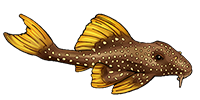dysichthys coracoideus
- Jotaro Kujo
- Posts: 2
- Joined: 24 Mar 2015, 22:15
- My Wishlist: 6
- Location 1: Legnaro
- Location 2: Padova
- Interests: Metal music, Singing, Guitar playing, Aquaria, Fish, Animals, Movies, Anime, Manga, Books, Plants.
dysichthys coracoideus
Hi guys! I'm going to buy 2 dysichthys coracoideus for my 120 l Amazonic tank. I'd like to know if anyone of you has ever breeded them because there is plenty of vegetation and the tankmates are small and peaceful, so I'd like to give a try...
We are a flame born in the wind
- bekateen
- Posts: 9701
- Joined: 09 Sep 2014, 17:50
- I've donated: $40.00!
- My articles: 4
- My images: 144
- My cats species list: 147 (i:106, k:32)
- My aquaria list: 37 (i:14)
- My BLogs: 46 (i:156, p:2637)
- My Wishlist: 36
- Spotted: 185
- Location 1: USA, California, Stockton
- Location 2: USA, California, Stockton
- Contact:
Re: dysichthys coracoideus
Hi Jotaro Kujo,
My have spawned at least 10 times over the last 2-3 years, and once I had the good fortune to watch it happen. I've written up all my notes in my breeding log, which you can read here: /my_blog.php?task=show&id=637&username=bekateen&species_id=25#637.
One piece of advice I have is buy at least 3 banjos, especially if you buy them without being able to sex them first. I started with 1 male and 2 females, and now I've got about 5-7 adults in the group.
Also, use a sandy substrate and they will love that. When they do spawn, the eggs will scatter and stick to decorations and plants. When I started, I found it convenient to use potted plants and leave the pots sticking up above the sand as a surface on which the eggs will stick. Now I also use short spawning mops anchored with sinker weights.
The eggs are tiny and a little green and hard to see. You have to look close to find them.
Good luck! Eric
EDIT: Also, if you want the eggs to survive, don't add any corys or plecos or any other fish that will forage near ground level to the tank. I don't know if the adult banjos will eat their own eggs, but I do know that I have never had a single egg survive in the community tank where my adults live and spawn. The only eggs that have survived were eggs which I removed from the tank and hatched in a 2gal hatching tank. To that end, if you're using such a large aquarium, I think you'll have a hard time finding the scattered eggs if you want to remove the eggs.
Also, the only other breeding report (my_blog.php?task=show&id=69&username=nvcichlids&species_id=25#69), by nvcichlids, states that the banjos spawned in a tank with Tanganyikan cichlids. I suspect that the reason his young hatched and survived in the tank with other fish was the presence of the shells decorating the substrate. The crevices between the shells probably provided lots of hiding places for the scattered eggs and newly hatched fry (until they were old enough to burrow into sand) to escape detection by the cichlids. I imagine that's kind of like tanks where people place a layer of marbles on the floor of the tank for catching/concealing the eggs of various other egg scattering species.
My have spawned at least 10 times over the last 2-3 years, and once I had the good fortune to watch it happen. I've written up all my notes in my breeding log, which you can read here: /my_blog.php?task=show&id=637&username=bekateen&species_id=25#637.
One piece of advice I have is buy at least 3 banjos, especially if you buy them without being able to sex them first. I started with 1 male and 2 females, and now I've got about 5-7 adults in the group.
Also, use a sandy substrate and they will love that. When they do spawn, the eggs will scatter and stick to decorations and plants. When I started, I found it convenient to use potted plants and leave the pots sticking up above the sand as a surface on which the eggs will stick. Now I also use short spawning mops anchored with sinker weights.
The eggs are tiny and a little green and hard to see. You have to look close to find them.
Good luck! Eric
EDIT: Also, if you want the eggs to survive, don't add any corys or plecos or any other fish that will forage near ground level to the tank. I don't know if the adult banjos will eat their own eggs, but I do know that I have never had a single egg survive in the community tank where my adults live and spawn. The only eggs that have survived were eggs which I removed from the tank and hatched in a 2gal hatching tank. To that end, if you're using such a large aquarium, I think you'll have a hard time finding the scattered eggs if you want to remove the eggs.
Also, the only other breeding report (my_blog.php?task=show&id=69&username=nvcichlids&species_id=25#69), by nvcichlids, states that the banjos spawned in a tank with Tanganyikan cichlids. I suspect that the reason his young hatched and survived in the tank with other fish was the presence of the shells decorating the substrate. The crevices between the shells probably provided lots of hiding places for the scattered eggs and newly hatched fry (until they were old enough to burrow into sand) to escape detection by the cichlids. I imagine that's kind of like tanks where people place a layer of marbles on the floor of the tank for catching/concealing the eggs of various other egg scattering species.
Find me on YouTube & Facebook: http://youtube.com/user/Bekateen1; https://www.facebook.com/Bekateen
Buying caves from https://plecocaves.com? Plecocaves sponsor Bekateen's Fishroom. Use coupon code bekateen for 15% off your order. Also, for you Swifties: Https://youtu.be/ZUKdhXL3NCw





